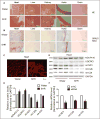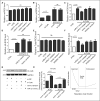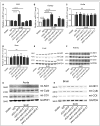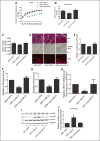MicroRNA-21 Lowers Blood Pressure in Spontaneous Hypertensive Rats by Upregulating Mitochondrial Translation
- PMID: 27542393
- PMCID: PMC5515592
- DOI: 10.1161/CIRCULATIONAHA.116.023926
MicroRNA-21 Lowers Blood Pressure in Spontaneous Hypertensive Rats by Upregulating Mitochondrial Translation
Abstract
Background: Excessive reactive oxygen species generated in mitochondria has been implicated as a causal event in hypertensive cardiomyopathy. Multiple recent studies suggest that microRNAs (miRNAs) are able to translocate to mitochondria to modulate mitochondrial activities, but the medical significance of such a new miRNA function has remained unclear. Here, we characterized spontaneous hypertensive rats (SHRs) in comparison with Wistar rats, finding that micro RNA-21 (miR-21) was dramatically induced in SHRs relative to Wistar rats. We designed a series of experiments to determine whether miR-21 is involved in regulating reactive oxygen species generation in mitochondria, and if so, how induced miR-21 may either contribute to hypertensive cardiomyopathy or represent a compensatory response.
Methods: Western blotting was used to compare the expression of key nuclear genome (nDNA)-encoded and mitochondrial genome (mtDNA)-encoded genes involved in reactive oxygen species production in SHRs and Wistar rats. Bioinformatics was used to predict miRNA targets followed by biochemical validation using quantitative real-time polymerase chain reaction and Ago2 immunoprecipitation. The direct role of miRNA in mitochondria was determined by GW182 dependence, which is required for miRNA to function in the cytoplasm, but not in mitochondria. Recombinant adeno-associated virus (type 9) was used to deliver miRNA mimic to rats via tail vein, and blood pressure was monitored with a photoelectric tail-cuff system. Cardiac structure and functions were assessed by echocardiography and catheter manometer system.
Results: We observed a marked reduction of mtDNA-encoded cytochrome b (mt-Cytb) in the heart of SHRs. Downregulation of mt-Cytb by small interfering RNA in mitochondria recapitulates some key disease features, including elevated reactive oxygen species production. Computational prediction coupled with biochemical analysis revealed that miR-21 directly targeted mt-Cytb to positively modulate mt-Cytb translation in mitochondria. Circulating miR-21 levels in hypertensive patients were significantly higher than those in controls, showing a positive correlation between miR-21 expression and blood pressure. Remarkably, recombinant adeno-associated virus-mediated delivery of miR-21 was sufficient to reduce blood pressure and attenuate cardiac hypertrophy in SHRs.
Conclusions: Our findings reveal a positive function of miR-21 in mitochondrial translation, which is sufficient to reduce blood pressure and alleviate cardiac hypertrophy in SHRs. This observation indicates that induced miR-21 is part of the compensatory program and suggests a novel theoretical ground for developing miRNA-based therapeutics against hypertension.
Keywords: MIR-21 microRNA, human; cytochrome b; mitochondria; reactive oxygen species.
© 2016 American Heart Association, Inc.
Figures










References
-
- Drazner MH. The progression of hypertensive heart disease. Circulation. 2011;123:327–334. - PubMed
-
- Lip GY, Felmeden DC, Li-Saw-Hee FL, Beevers DG. Hypertensive heart disease. A complex syndrome or a hypertensive ‘cardiomyopathy’? Eur Heart J. 2000;21:1653–1665. - PubMed
-
- Teng L, Zheng J, Leng J, Ding Y. Clinical and molecular characterization of a Han Chinese family with high penetrance of essential hypertension. Mitochondrial DNA. 2012;23:461–465. - PubMed
-
- Nikitin AG, Lavrikova EY, Chistiakov DA. The heteroplasmic 15059G>A mutation in the mitochondrial cytochrome b gene and essential hypertension in type 2 diabetes. Diabetes Metab Syndr. 2012;6:150–156. - PubMed
-
- Ding Y, Xia B, Yu J, Leng J, Huang J. Mitochondrial DNA mutations and essential hypertension (Review) Int J Mol Med. 2013;32:768–774. - PubMed
Publication types
MeSH terms
Substances
Grants and funding
LinkOut - more resources
Full Text Sources
Other Literature Sources
Medical

